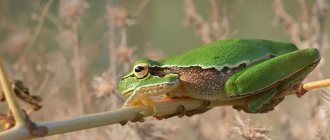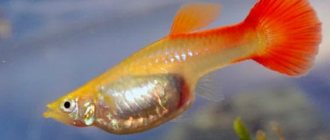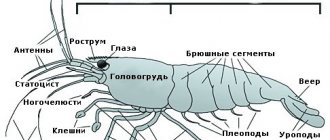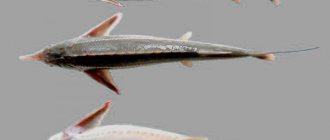The fish are sleeping, they are tired. How do fish sleep?
Oh those stereotypes
How do fish sleep?
Do all fish sleep the same?
Only fish of the bony type can hover in the water column and drift during sleep. They manage to do this thanks to the presence of a swim bladder filled with air. The volume of air in this special organ determines at what height the fish will be in the aquarium. The smaller it is, the deeper it will sink into the water column. Most inhabitants of home aquariums are bony fish.
Stingrays and sharks are cartilaginous fish and do not have a swim bladder. How do fish sleep if they cannot hang in the water? They lie on the bottom or rest while moving. Cartilaginous fish suitable for keeping in an aquarium include ancistrus and loachfish.
There are also underwater inhabitants who need to hide in a cave to sleep. Parrotfish sleep very unusually - practically under a blanket. The only thing they use is mucus, which is released by the fish through the mouth. The mucus envelops the carcass, creating a protective cocoon in which you can rest peacefully and not be afraid of anything. In the morning, the fish leaves its “blanket”.
Why do you need to know about the sleep habits of fish?
Character and disposition of aquarium pets
The character of the guppy fish is calm and peaceful. It is strictly forbidden to keep individuals in the same container with predators . Aggression of guppies can manifest itself among themselves, in a single flock. Negative factors heat up the relationship - large crowds, bad water, diseases. Lack of air or concentrates in water can also provoke aggression towards each other.
Compatibility: who should you keep your guppies with?
Compatibility table for gupeshkas with other fish species.
- Small catfish swim slowly and live in the lower water layer. Individuals have a quiet disposition. A special feature is the gradual purification of water from waste and food debris. If such individuals live in the aquarium, it is forbidden to add salt to the water.
- Malaysian glassfish (Indian fish) and guppies are the best companions. Peaceful nature and high level of endurance. Their body has a transparent body, all organs are visible through. Feature: gregarious behavior. Fish are especially sensitive to changes in water composition.
- Fish of the Poeciliaceae family can breed with guppies, producing hybrid offspring.
- Tropical fish – neon tetra or “pearl of the aquarium”. Characteristics: blue body, strong schools of 7 individuals, swimming in the middle layer.
- Dwarf loaches can reach the same size as guppies. They create families of 3 individuals. It is recommended to create a special shelter for them from living plants (for rest and camouflage).
It is not recommended to keep guppies with adult angelfish, swordtails, barbs, and goldfish. Representatives of these species can bite guppies, eat their offspring, and bite off their tails and fins.
Do fish sleep or not :: how do aquarium fish sleep :: Natural Sciences
All animals need rest, but some of them cannot be told by their appearance whether they are sleeping or not. Similar difficulties are observed, for example, with fish. Even during sleep, their eyes remain open, which often confuses people and prevents them from correctly interpreting the condition.
The question “And yet! What came first? “Egg or chicken?” - 12 answers
Why don't fish close their eyes?
Fish, like other representatives of fauna, sleep. Only they don’t close their eyes. This is because fish simply do not have eyelids. This difference from humans and terrestrial fauna is due to the environment in which they live. People have to constantly moisturize the outer layer of the eye by blinking. It is very difficult to do this in a dream, so the eyelids tightly close the cornea, protecting it from drying out. Fish live in water, which does not allow their eyes to dry out. They do not require additional protection. Only some sharks have eyelids. During an attack, the predator closes its eyes, thereby protecting the eye from damage. Sharks that don't have eyelids roll their eyes.
How do bony fish sleep?
Aquarists can sometimes observe how their pets lie down on the ground or algae, freeze with their belly up or perpendicular to the bottom. However, as soon as you make a sudden movement or turn on the light, the pets begin to swim again, as if nothing had happened. All fish sleep very sensitively. Most species choose a quiet, secluded place to sleep, but they all have their own habits. For example, cod can lie sideways on the bottom, herring can hang head down in the water, flounder can bury itself in the sand. The bright tropical parrotfish is a great original. In preparation for sleep, she builds a cocoon of mucus around herself, which apparently prevents predators from detecting her by smell. All types of fish, depending on the time of their activity, can be divided into day and night.
How do cartilaginous fish sleep?
The structure of bony and cartilaginous fish differs. Cartilaginous fish, which include sharks and rays, do not have covers on their gills, and water enters them only during movement. Because of this, they were unable to sleep peacefully. However, in the course of evolution, they managed to adapt and snatch hours of rest for themselves. Some species have acquired squirts - special organs behind the eyes, with the help of which fish draw in water and direct it to the gills. Others prefer to choose places to sleep with a strong bottom current or sleep with their mouths constantly opening and closing, thereby allowing the water to saturate the blood with oxygen. The Katran shark, which lives in the Black Sea, even sleeps while moving. The spinal cord is responsible for movement, while the brain can rest at this time. Scientists also believe that some representatives of cartilaginous fish can sleep like dolphins, alternately “turning off” the right and left hemispheres.
Classification of fish by activity at different times of the day
According to activity at different hours, fish are divided into:
- Crepusculars are primarily carnivorous species. They see well in the dark, hunt at night, and rest during daylight hours.
- Diurnal are species that rest at night and lead an active lifestyle during the day. For example, guppies, angelfish, cockerels.
An aquarium with fish must be organized so that diurnal and crepuscular species do not live together. Otherwise, nocturnal predators will begin to hunt their neighbors, and in the daytime they will suffer from excess light.
Guppy fish, photo-video review of maintenance, compatibility and breeding
The photo shows a female guppy
The photo shows a male guppy
The fry do not need parental care: they stay in a flock near the surface and constantly ask for food. The best food for them are ciliates, which babies should be fed at least 4-5 times a day. As you grow. the number of feedings is reduced to twice a day, and the food itself becomes more “adult”: artemia nauplii, chopped bloodworms, etc.
When breeding guppies, pay special attention to the fry. The fry do not grow very quickly, but that is not the problem. The fact is that the fry grow unevenly. In this case, smaller and weaker individuals risk dying from starvation: strong and healthy fry simply do not allow the weaker ones to eat. Therefore, you should sort the fry by size and place them in different jars.
Sometimes, during childbirth, “force majeure” circumstances may arise: the female cannot give birth. In this case, you need to help her: change the water in the spawning area (50%) and raise the temperature to 28*C+29*C. In this case, the female guppy will definitely give birth.
The fish reach sexual maturity at the age of 4-5 months.
Beautiful photo selection of guppies
Great video about guppy
Sleep Features
Any living organism needs at least short-term periodic rest, without which it is impossible to do without damage to health for a long time. Terrestrial living beings - people, animals, birds, even reptiles and mollusks - sleep according to almost the same principle: the eyes are closed (or half-closed) for centuries, the body's vital processes slow down, muscles relax, consciousness becomes dull (sometimes completely switched off).
Only the postures taken during sleep differ, as well as the degree of adequacy of the senses in individual representatives of terrestrial living beings. A person is used to sleeping lying down, although, if necessary, he can fall asleep in other positions of his body: sitting and even standing in special - extreme - cases.
Everyone knows that, for example, elephants sleep standing up, horses also often fall asleep in the same position, but can also sleep lying down. Some parrots like to hang upside down in their sleep, clinging to a branch with their clawed paws.
Sleep in fish has its own characteristics that differ from our usual understanding of this useful and vital phenomenon. In other words, a sleeping fish is not an individual in an unconscious state , as sleeping animals or humans might be characterized, since its brain activity remains, according to scientific research, almost at the same level.
Any change in an external factor that affects, at least indirectly, a sleeping fish immediately returns it to its normal state. Deep sleep is a completely unknown physiological state to them.
The maximum that fish can allow themselves during rest is a slight weakening of the perception of the surrounding reality, as long as this environment does not touch it in any way, as well as almost complete inaction . At the same time, they see and hear everything, ready at any moment to rush into an attack or, conversely, hide from a predator. This is probably similar to a person waiting for a train at a station, who cannot even sleep for fear of missing the departure, and is tired of everything happening around him during the long hours of waiting.
His state is similar to that of a sleepy fish: he doesn’t sleep, and doesn’t care about his surroundings at all until the long-awaited invitation to land comes.
Angelfish: breeding at home
Sex determination in angelfish and pair formation
Sexual dimorphism in angelfish is not pronounced, i.e. males and females are almost the same in appearance. It is impossible to determine gender before the onset of puberty, and even then it is quite difficult. Aquarists joke about this: “If it swam, it means a male, if it swam, it means a female.” However, in adult angelfish it is possible to determine the sex in most cases, although this can usually only be done by those who know the anatomy of fish well. Let's try to figure out what characteristics determine the gender of fish of this genus:
- In mature males, there is a fatty hump on the forehead;
- Males have a more convex pectoral carina;
- If you look at the fish from the front, then the lower part of its body resembles a wedge, and in the male this wedge is sharp, and in the female it is blunt;
- The diagnostic sign is the genital papilla (in females it is called the ovipositor) - a growth with an opening located between the anus and the anal fin, through which reproductive products come out. In females it is larger and thicker, while in males it is correspondingly thinner, sharper and directed backwards. These differences are especially clearly visible during spawning, as well as before and immediately after it;
- The distance from the genital papilla to the anal fin is much shorter in males than in females. In fact, in males the fin keel grows directly from the genital papilla, and since in striped angelfish the papilla is usually located at the base of the central stripe, we can say that in males the anal fin starts from the base of the central stripe, and in females - behind it;
Male angelfish differ from females in having a more elongated, long dorsal fin. In its rear part there are dark transverse stripes interspersed with gaps. The number of these stripes in females is no more than 6, and in males there are no less than 7. However, sometimes it is impossible to reliably determine the gender of fish based on these characteristics, especially in artificially bred forms with marbled, golden, albino coloring. In such cases, they try to determine the sex of the fish by their behavior when they form pairs and begin spawning in a common aquarium. But this does not always work: in some cases, in the absence of males, females play their role in mating games and spawning, and same-sex couples even lay eggs (which, naturally, remain unfertilized).
Here we can advise the following: if you want to purchase an adult breeder fish, choose an individual with characteristic features and behavior, or a fish that has already given birth to offspring. It’s even better if it’s an established couple right away. If you are going to raise breeders yourself, purchase 8-10 fry with wide and long fins, among them there will definitely be individuals of both sexes, and in the future they will split into pairs themselves, and you can decide which of them to use for further breeding.
Angelfish prefer to form pairs on their own, choosing a partner from several individuals of the opposite sex. But the aquarist may well choose a pair of an existing young specimen. When a male and female angelfish of similar age and size find themselves alone in an aquarium, as a rule, they begin to “build love.” It is not recommended to separate ready-made couples and select other partners - this is extremely stressful for fish, and they do not always form new unions. It is easy to identify a formed pair: the fish stay together, swim in single file, and the male begins to drive the female into the corners of the aquarium.
Raising spawners and preparing for spawning
Fish that are planned for further breeding must be kept in optimal conditions. For angelfish, the water temperature is of particular importance, which should not be lower than 27°C. The second most important factor is the quality of food; future producers must eat live food (bloodworms, tubifex, daphnia, etc.) or frozen food throughout their lives. Angelfish raised exclusively on dry food are usually smaller in size, their coloration is paler, and they are often incapable of reproduction.
In good conditions, angelfish can spawn every two weeks, provided the eggs are removed immediately.
Before spawning, males and females must be kept together, since the preparation of males for spawning and the maturation of their reproductive products takes place only in the presence of females.
Spawning is stimulated by increasing the water temperature by 2°C, frequent changes (3-4 times a week, 10%), while it is better to add distilled or boiled water to reduce its hardness in the aquarium. The aquarium should contain large-leaved plants; you can also place a piece of plastic or ceramic tile there on which the angelfish can spawn. Typically, fish of this genus are not placed in a separate spawning tank, allowing them to spawn in a general aquarium.
A pair ready for reproduction can be recognized by the female’s rounded abdomen and changed behavior - future parents begin to zealously guard their territory and clean the surface on which they will spawn.
Spawning
Incubator equipment and egg development
Angelfish, like other cichlids, care for their offspring, but their parental instinct is not so strong, and this care usually lasts only 2-3 days. Having spawned, the spawners begin to protect the eggs from other fish in the aquarium, fan the eggs with their pectoral and dorsal fins, pick up the eggs that have fallen from the substrate and eat the white ones. In some cases, they take care of their offspring until they begin to feed on their own. I must say that this care is very useful for the fry. But, unfortunately, such exemplary behavior is rather an exception to the rule, and usually producers simply eat the eggs a few hours after spawning or after dark. Therefore, if you do not want to risk finding out how caring parents your angelfish are, it is better to transfer the eggs to a separate aquarium 2-3 hours after spawning.
An incubator for caviar is prepared as follows: a small aquarium with a capacity of 5–10 liters is half filled with water from the aquarium where the breeders are kept. The second half is added with distilled water. A heater set to a temperature of 30°C and an air sprayer are placed in the incubator, and after an hour, the substrate with eggs is lowered into it so that the eggs are washed by the current from the sprayer, but air bubbles do not fall on it.
To prevent fungal infection of eggs, add methylene blue to the water until it turns intensely blue or Sera mycopur at the rate of 1 drop per liter. It is useful to place small plants in the incubator, such as duckweed or riccia, they will act as a biofilter, preventing the level of nitrogen compounds in the aquarium from jumping when the fry begin to grow quickly. In addition, ciliates and rotifers will multiply in the thickets, which will then become food for the fry. Lighting should be around the clock. Even if there are no plants in the incubator, you should leave the night light on at night.
The next day, the whitened eggs are removed.
Development of fry and care for them
After two days, the shells of the eggs rupture and turn into sticky ropes on which the larvae hang, moving with the help of a tail similar to a flagellum. On about the fourth day, the larvae can distinguish their heads and yolk sacs, from the reserves of which they feed. The larva constantly moves, trying to free itself from the cord that attaches it.
After 7–12 days, the cords break off and the fry begin to swim. By this time, the yolk sac is almost empty, and it is time to start feeding the fry. It is impossible to fully feed them with egg yolk and dry food, so live food is prepared in advance: ciliates and daphnia are bred, and on the 5th day after spawning, they begin to incubate artemia. The fry are fed 5–6 times a day. Now you need to place a small filter in the aquarium, and to prevent the fry from being drawn in, the lower part of it is covered, for example, with a nylon stocking. If there are a lot of fry, some will need to be removed from the aquarium; their density should now be no more than two per liter of water, otherwise the level of ammonia and nitrites may rise sharply. Water changes are carried out once a day by a third, before feeding, after removing the remaining food from the bottom with a siphon.
In about a month or a month and a half, the fry will acquire the shape characteristic of an angelfish, after which they will again need to be seated in a container at the rate of 4–5 liters of water per fry. At this age, they are fed with chopped tubifex, small bloodworms, they can begin gradually accustoming them to live food, and after a short time they can be placed in a common “adult” aquarium.
As you can see, breeding angelfish is a troublesome, painstaking, but very interesting task. Even if you don’t get everything right the first time, you will have a chance to try again, because a couple of healthy fish in good conditions spawn often. And sooner or later, the persistent aquarist will be able to boast of a flock of bright young angelfish, which he raised from eggs. Now all that remains is to find them a new home, thereby increasing the number of lovers of these amazing fish.
Read about keeping angelfish in the following article, and now a short video about the spawning of these fish:
What to feed guppies?
Currently, in pet stores you can find a large number of nutritious flakes and granulated food for fish of various breeds. They contain vitamins and essential minerals. Beginner aquarists are better off choosing these foods.
Experienced fish owners often create various mixtures themselves and pamper their pets with delicious dishes. For those who want to feed their guppies not with dry concentrates, but with more tasty food, we can recommend using live food in the form of small bloodworms, tubifex, and coretra. These are the larvae of various aquatic insects, that is, exactly what the inhabitants of natural reservoirs feed on. In addition, fish need green food. Guppies usually eat algae deposits on plant leaves and glass.
The fry do not need to be fed for the first 1-2 days of life. At this time, they absorb the contents of the yolk sac. But immediately after hatching the young animals, you need to provide them with high-quality live food:
- artemia nauplii;
- ciliates;
- Daphnia and Cyclops.
Night illumination (lighting) of the aquarium
Recently, the so-called night illumination of aquariums has become popular among amateur craftsmen. Its more romantic name is LUNAR. In order to observe their pets at night, they themselves make soft and diffused ( night ) lighting.
Despite the fact that most aquarium owners are sure that fish should be in complete darkness at night, this is not entirely true. In natural living conditions, darkness certainly envelops natural bodies of water at night, but we must not forget about the illumination by the moon and stars. And this dim, diffused light is also of undeniable importance for providing comfortable living conditions for the inhabitants of aquariums .
|
Perhaps, after all, proper night lighting for an aquarium looks like this when only part of the reservoir is slightly illuminated, while the other is in complete darkness. Such a smooth transition is partly necessary so that the fish themselves have the opportunity to choose the most suitable light environment for them.
And finally, an aquarium illuminated with such fabulous beauty not only brings a certain charm to your home interior, but also helps you relax after a busy day at work. And it’s so pleasant and easy to fall asleep, immersed in the play of shadows that float in the rays of bewitching color and light.
What breeds of guppies do you prefer?
It is best for beginning lovers of these creatures to opt for the simplest varieties that have beautiful names:
- Berlin guppies are veil-tailed, with red fins and a silver body, dark at the tail (semi-black);
- carpet - silver or bluish, with yellow or red fins with black speckling;
- Canadian - silver, dark towards the tail, with white fins;
- half-black leopard - with a bright yellow tail, decorated with large black spots, reminiscent of the color of a wild cat.
Very beautiful types of multicolor guppies are forms with multi-colored fins, combining red, blue and greenish shades, with black spots (Multicolor Neon, etc.). They resemble other fish - neons, but differ from them in the size of the caudal fin (Fig. 3).
Representatives of another species of guppies will not leave fans indifferent. They have a light body, half black (in the tail), a black rounded fin, a dark spot on the head and around the eyes (Fig. 4). This coloring made it possible to call these guppies “panda”, like the well-known bamboo bears.
There are many more selective breeds that require some experience in caring for. In order for such fish to safely spend the life span allotted to them by nature - about 3 years - the aquarist must master the basic skills of caring for aquatic inhabitants. Even with all the simplicity of caring for guppies, keeping them at home turns out to be very difficult, and the conditions are vital for the capricious, expensive breeding varieties.
Night life of the aquarium
Observing your aquarium and its inhabitants is perhaps the most favorite pastime of their owners. This usually happens during the day and while awake, but the most curious cannot help but be interested in the question - what do their pets do at night?
The aquarium world is no less interesting at night than during the day, and, moreover, full of secrets and mysteries. The night aquarium only seems to sleep in silence, but at the same time stores many interesting events and phenomena.











